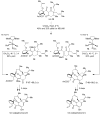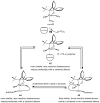Catalytic enantioselective olefin metathesis in natural product synthesis. Chiral metal-based complexes that deliver high enantioselectivity and more
- PMID: 19967680
- PMCID: PMC3517032
- DOI: 10.1002/anie.200904491
Catalytic enantioselective olefin metathesis in natural product synthesis. Chiral metal-based complexes that deliver high enantioselectivity and more
Abstract
Chiral olefin metathesis catalysts enable chemists to access enantiomerically enriched small molecules with high efficiency; synthesis schemes involving such complexes can be substantially more concise than those that would involve enantiomerically pure substrates and achiral Mo alkylidenes or Ru-based carbenes. The scope of research towards design and development of chiral catalysts is not limited to discovery of complexes that are merely the chiral versions of the related achiral variants. A chiral olefin metathesis catalyst, in addition to furnishing products of high enantiomeric purity, can offer levels of efficiency, product selectivity and/or olefin stereoselectivity that are unavailable through the achiral variants. Such positive attributes of chiral catalysts (whether utilized in racemic or enantiomerically enriched form) should be considered as general, applicable to other classes of transformations.
Figures















Similar articles
-
Design and stereoselective preparation of a new class of chiral olefin metathesis catalysts and application to enantioselective synthesis of quebrachamine: catalyst development inspired by natural product synthesis.J Am Chem Soc. 2009 Jan 28;131(3):943-53. doi: 10.1021/ja8084934. J Am Chem Soc. 2009. PMID: 19113867 Free PMC article.
-
Catalyst-controlled stereoselective olefin metathesis as a principal strategy in multistep synthesis design: a concise route to (+)-neopeltolide.Angew Chem Int Ed Engl. 2015 Jan 2;54(1):215-20. doi: 10.1002/anie.201409120. Epub 2014 Nov 6. Angew Chem Int Ed Engl. 2015. PMID: 25377347 Free PMC article.
-
The remarkable metal-catalysed olefin metathesis reaction.Nature. 2007 Nov 8;450(7167):243-51. doi: 10.1038/nature06351. Nature. 2007. PMID: 17994091 Review.
-
A readily available chiral Ag-based N-heterocyclic carbene complex for use in efficient and highly enantioselective Ru-catalyzed olefin metathesis and Cu-catalyzed allylic alkylation reactions.J Am Chem Soc. 2005 May 11;127(18):6877-82. doi: 10.1021/ja050179j. J Am Chem Soc. 2005. PMID: 15869311
-
Molybdenum and tungsten imido alkylidene complexes as efficient olefin-metathesis catalysts.Angew Chem Int Ed Engl. 2003 Oct 6;42(38):4592-633. doi: 10.1002/anie.200300576. Angew Chem Int Ed Engl. 2003. PMID: 14533149 Review.
Cited by
-
Synthesis of C14-C21 acid fragments of cytochalasin Z8 via anti-selective aldol condensation and B-alkyl Suzuki-Miyaura cross-coupling.RSC Adv. 2018 Jan 22;8(7):3899-3902. doi: 10.1039/c7ra13391j. eCollection 2018 Jan 16. RSC Adv. 2018. PMID: 35542899 Free PMC article.
-
Alkyne elementometalation-Pd-catalyzed cross-coupling. Toward synthesis of all conceivable types of acyclic alkenes in high yields, efficiently, selectively, economically, and safely: "green" way.J Org Chem. 2010 May 21;75(10):3151-82. doi: 10.1021/jo1003218. J Org Chem. 2010. PMID: 20465291 Free PMC article.
-
Rh-Catalyzed Enantioselective Single-Carbon Insertion of Alkenes.J Am Chem Soc. 2024 Aug 7;146(31):21837-21846. doi: 10.1021/jacs.4c06158. Epub 2024 Jul 26. J Am Chem Soc. 2024. PMID: 39058396 Free PMC article.
-
Ruthenium-catalyzed intramolecular [2+2+2] cycloaddition and tandem cross-metathesis of triynes and enediynes.ChemistryOpen. 2013 Apr;2(2):63-8. doi: 10.1002/open.201300002. Epub 2013 Feb 19. ChemistryOpen. 2013. PMID: 24551536 Free PMC article.
-
Traceless Protection for More Broadly Applicable Olefin Metathesis.Angew Chem Int Ed Engl. 2019 Apr 8;58(16):5365-5370. doi: 10.1002/anie.201901132. Epub 2019 Mar 13. Angew Chem Int Ed Engl. 2019. PMID: 30747464 Free PMC article.
References
-
- Grubbs RH, editor. Handbook of Metathesis. Wiley–VCH; Weinheim: 2003.
-
- Hoveyda AH, Zhugralin AR. Nature. 2007;450:243–251. - PubMed
-
- Houri AF, Xu Z, Cogan DA, Hoveyda AH. J Am Chem Soc. 1995;117:2943–2944.
- Xu Z, Johannes CW, Salman SS, Hoveyda AH. J Am Chem Soc. 1996;118:10926–10927.
- Xu Z, Johannes CW, Houri AF, La DS, Cogan DA, Hofilena GE, Hoveyda AH. J Am Chem Soc. 1997;119:10302–10316.
-
-
For two noteworthy applications to natural product synthesis wherein the reversible nature of catalytic cross-metathesis is utilized, see: Smith AB, III, Adams CM, Kozmin SA, Paone DV. J Am Chem Soc. 2001;123:5925–5937.Fürstner A, Thiel OR, Ackermann L. Org Lett. 2001;3:449–451.
-
Publication types
MeSH terms
Substances
Grants and funding
LinkOut - more resources
Full Text Sources
Other Literature Sources

